Hiking Poles, Hiking Sticks, Trekking Poles, Poles, Sticks…. These carbon fibre or aluminum rods are a gift from the heavens and in my opinion, are one of the most important and impactful tool in a hikers arsenal.
These simple sticks have an insane array of benefits when it comes to improving on-trail performance and experience. They can reduce strain on your lower body and joints, help you walk faster, further, keep you more stable, balanced and even be used as your tent poles or a weapon to fight off wildlife. Okay, I’ll have to admit, fighting off wildlife with your hiking poles is far-fetched, and a bear will win 100% of the time regardless of if you or wielding hiking poles or not. So hold on to that BEAR SPRAY.
It’s all personal preference, and some people really hate hiking poles. Some of my trail running buddies compare me to a suburban walker out for a rip with Nordic walking poles (which I think is awesome). But, I’m happy to look less cool and use my trekking poles because my knees feel better than ever . Thanks to hiking poles I may be able to continue trail hiking until I’m 80. Hiking poles are built so light and versatile these days that other than being an extra expense and a teeny bit of additional weight, I don’t see too many reasons not to hop on the bandwagon.
This article is going to detail the benefits and drawbacks of hiking poles and educate you about everything you need to know before buying your first set of sticks!
Let’s Get To It
Table of Contents
Do You Need Hiking Poles?
The simple answer is NO. Hiking poles are absolutely not required to enjoy a day on the trail. There are many hikers like myself who swear by them and others who just don’t appreciate the feel. Hiking is all about enjoying yourself and the outdoors. If you find hiking poles uncomfortable or annoying to use then you absolutely should leave them at home. Personally, I move with better rhythm and flow with my poles and my knees, oh my temperamental knees… They’ve never felt better!

Who Are Hiking Poles Best For?
Trekking poles are great for everyone across the hiking spectrum. It doesn’t matter your age, hiking style or objectives. From Nordic walkers in the suburbs to competitive trail runners, hiking poles take serious strain off the lower body and make walking and hiking more enjoyable. If you’ve ever had knee, hip, lower back or joint pain when hiking, don’t think twice before bringing a pair along on the trail.
The Benefits (Why You Should Use Hiking Poles)
Reduced Strain On Your Lower Body and Joints
Hiking poles distribute the weight of your upper body and pack directionally through the trekking poles. Your chest, shoulders and arms will become more activated and using poles has been proven to reduce upwards of 20-30% of the weight off each side when you step forward. Not only is this a great upper body workout but this is great news for your lower body and joints. I used to struggle with unbearable knee and lower back pain on the downhill portion of hikes. Trekking poles changed the game for me reducing my knee and back pain all together. For those who want to enjoy the outdoors so long as they live, hiking sticks are the fountain of youth and your ticket to optimizing the longevity of your most important body parts.
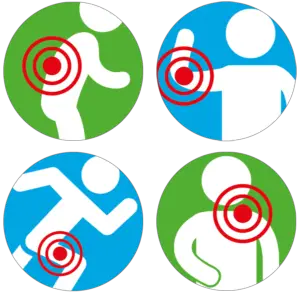
Increased Stability
Instead of having 2 points of contact with the earth, you now have 4. Wild animals move through the forest so gracefully, and now, with 4 points of contact to the forest floor, you are going to be able to better mimic the movements of our furry friends. Although you won’t be galloping like a gazelle the increased stability trekking poles provide is invaluable on the trail. When carrying a heavy pack balancing on technical or wet terrain is tough. Having the additional support of your poles allows you to stay on your feet if you lose footing or take a bad step. I also love using poles when crossing streams to test the depth of the water to know where I can take my next step.

Hiking Faster & Further
Hiking is all about having rhythm and pace. If you need to cover some serious miles you want to make sure your first hour is just as fast as your fifth hour. I find that hiking poles help dial in my timing and rhythm and actually help me to speed things up. Pushing off your hiking poles with your arms can actually propel you forward helping you use less energy in your legs and move along the trail faster. Although you might be burning a few extra calories by using your arms, I can cover way more distance and feel way less spent when using my poles.

Poles as The Ultimate Multi-Tool
Hiking poles don’t just have to be used for walking, believe it or not, they can be used in many different scenarios. If trails are overgrown I use them like a machete to part brambles and keep them off my face. Depending on the time of the year and if you are the first person on the trail for the day you may find yourself walking through silkworm thread or spiders webs. I hate getting stuck with silk, so once again, I use my poles to part the threads. Many ultra-light hikers sleep under trekking pole/tarp tents and their poles are the structure to their shelter. The REI Flash Air 2 Tent weighs under 2lb and can be pitched using your trekking poles! They can even be used as a splint in an emergency situation or to fight off irritated wild animals. But for me, my favourite use of my hiking pole is as my go-pro mount. I do a lot of filming while hiking and it’s ideal to be able to leave my go-pro on a hiking pole and be able film at any point in time without accessing my pack.
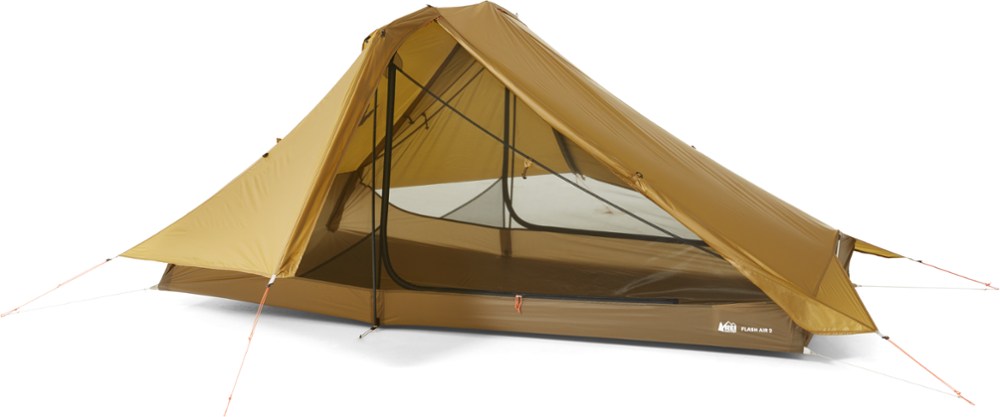
Disadvantages (Why You Shouldn’t Use Hiking Poles)
To be frank, I don’t really think there are too many deal breakers when it comes to using hiking poles, they are just that gosh dang helpful. But, to be an educated hiker you’ve got to understand the pitfalls, so I dug a few up. Here They Are.
You Hate The Feeling of Using Them
A small percentage of people love having their hands free while hiking and hate the feeling of using poles. In my opinion this is probably the most legitimate reason not to use hiking poles. Hiking is all about feeling good and enjoying the outdoors. If having your palms occupied by poles makes you unhappy, it’s not for you! Sometimes it takes a few outings to get used to poles especially if you have been hiking for years without. But trust me, if you do feel like breaking your old habits, you’ll be kicking yourself for not using them all those years.
More Weight
Weight is the main disadvantage to trekking poles, but this is small potatoes. Unless you are a competitive trail racer, the modern carbon fibre poles are so light that you barely notice them when strapped to your backpack. Even if you opt for a more affordable and heftier hiking pole, you aren’t going to notice the weight difference on your back because they should always be in your hands when you are moving. For ultra-light minimalist hikers who don’t use poles to support their shelter or tent, poles might not be suitable for their style.

Burning More Energy
Since you are activating your upper body with hiking poles you are burning more energy. This is absolutely the case with Nordic walking when you are moving your arms for the sole purpose of getting a workout. However, while hiking you are using your poles to assist and not as a workout tool. Hiking long distances and crushing lots of vertical is exhausting on the body no matter which way you slice the pie. If you do not have the assistance of your poles, that energy is just going to be transferred to your lower body. I do not have any scientific data on this one, and it’s just personal opinion. If there was a difference between the two styles in terms of energy consumption I’m sure the results would be negligible.
Another Piece of Equipment to Buy
Cost is definitely a barrier and the downside of hiking poles. Like any piece of hiking equipment, the more you are willing to spend, the higher the quality and the lighter the weight. However, if you’re just starting out and don’t want to spend a dime, use an old pair of aluminum ski poles they’ll work just fine!

It Looks Lame
The outdoors and hiking isn’t a fashion show. You can wear whatever you want and be whoever you want in the outdoors, but don’t go out of your way to uphold some sort of hardcore image. Once you get over the fact that you look like the legendary Nordic walker from your neighbourhood and your friends stop harassing you, you’ll be he coolest in the group knowing you’ve optimized your stride and are saving your body in the long-term.

Damaging Sensitive Ecosystems
This concern is valid and I think all outdoors people need to practice leave no trace ethics and respect nature at all times. Hiking poles can scar rocks, create indents in the earth, and damage plants and other vegetation. If poles are used wisely, and you ensure that you are only using them on maintained trails and non-sensitive areas then you will not damage fragile ecosystems. The onus of responsibility is not on poles themselves but on how the user wields the power of the hiking pole. Okay, this isn’t Star Wars, but please be mindful when you are out hiking and refrain from stabbing the wrong things.
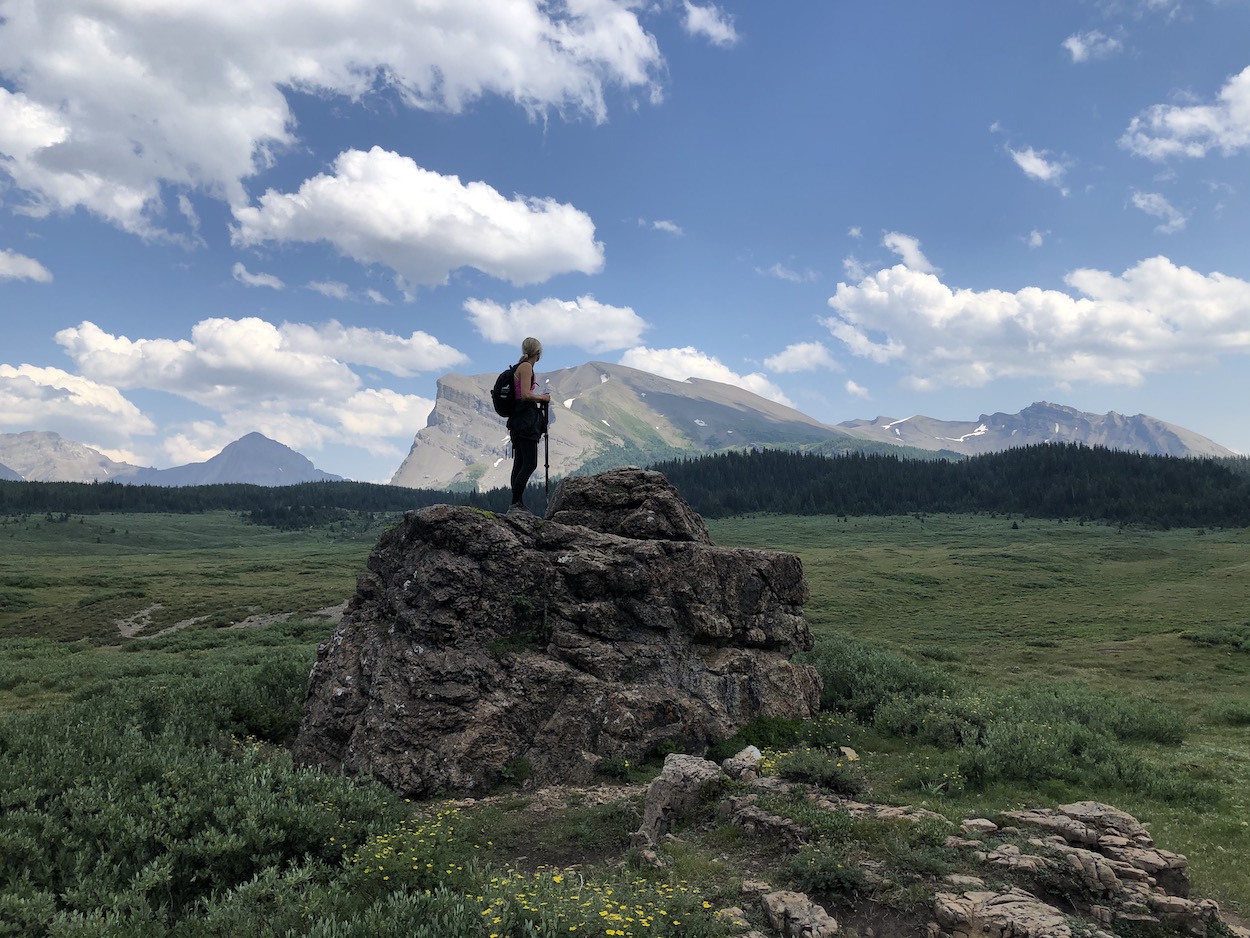
Lower Body Balance and Strength Become Worse
Some hikers have concerns that becoming reliant on poles will make their stride, balance, and stability worse. If you are a very serious trail runner, there may be merit to this. However, even if you are using poles, you are still putting loads of strain on your tendons and working every muscle in your lower body big and small when hiking. If you hike lots, even with poles, you are going to be strong and have killer balance!
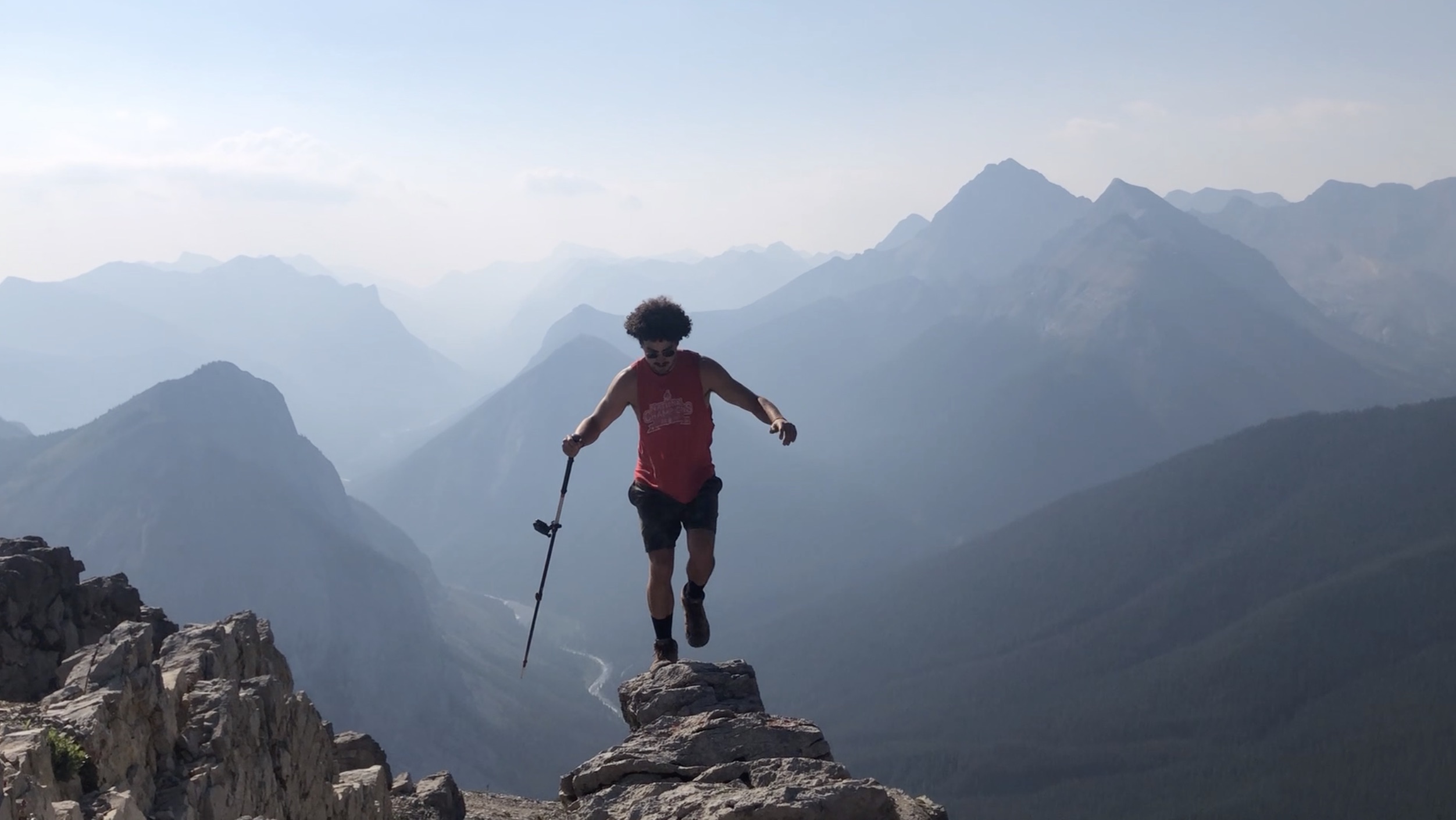
They Make An Annoying Ticking Noise On The Ground
Some people want to enjoy the serenity of nature and don’t want to hear anything but the sounds of their feet. If you are on harder terrain you’ll have to get used to the constant ticking of your poles. For some, this noise pollution is too much to bear.
When Are The Best Times To Use Hiking Poles
Steep Ascents and Descents
Hiking poles can be used walking on any sort of surface but truly shine on the ascent and descent. Nothing is harder on the knees than the pounding of your legs working their way down the steep mountain side. Some hikers opt to keep their poles strapped on their bag for the uphill and only feel the need to use them when hiking down.

When Wearing a Heavy Pack
If you are wearing a heavy pack, regardless of the terrain, poles will help disperse the weight and keep you more comfortable and allow you to hike for even longer without tiring.
Long Trails
Hiking on long and challenging trails can be a seriously exhausting feat when moving fast. The improved speed, stride and stability of using poles can allow you to cover more miles and feel less exhausted.
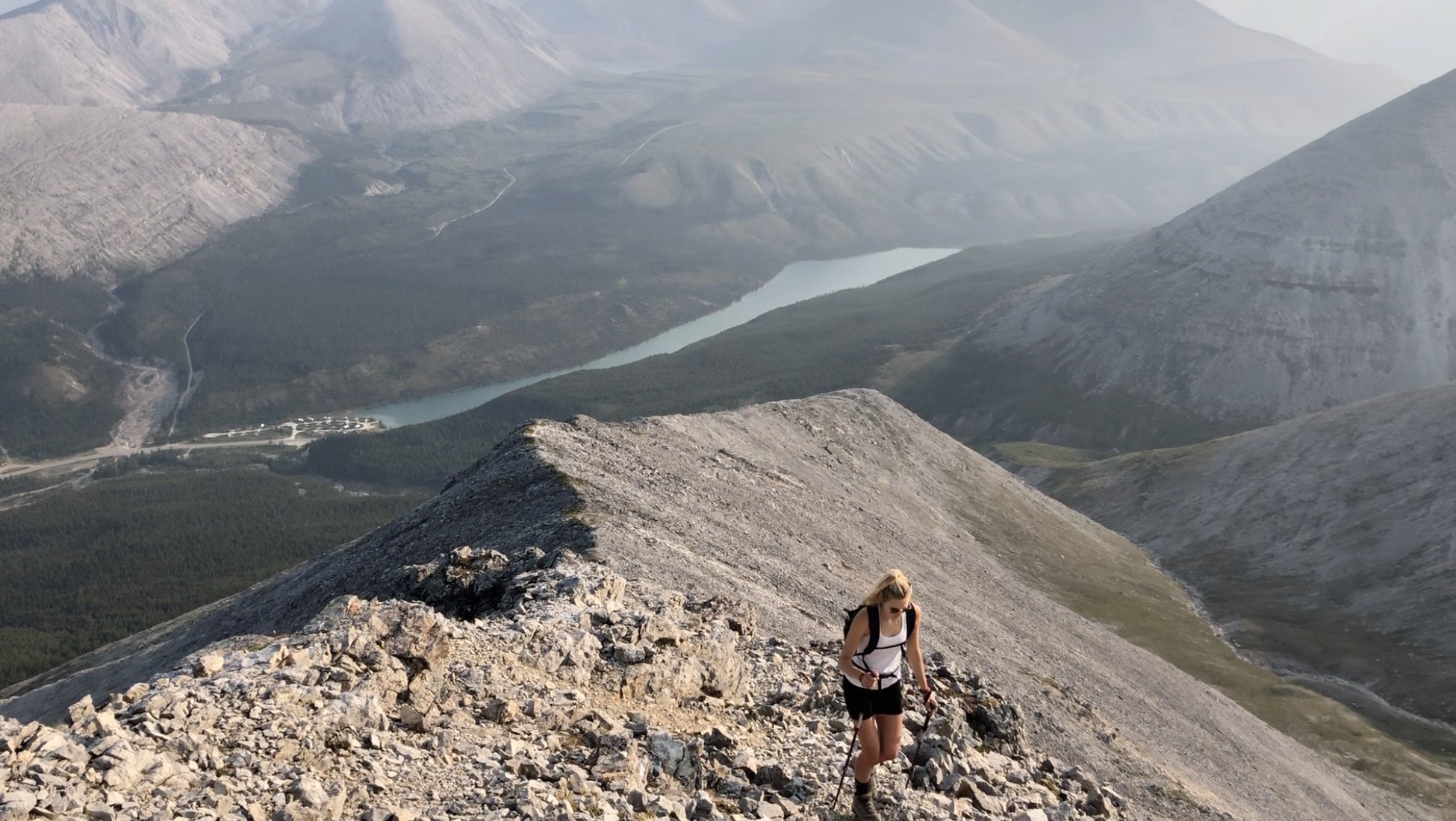
Hiking Pole Technique
Using hiking poles improperly can expend unnecessary energy and make you worse off when you are on trail. The proper technique is very simple. Use the poles asymmetrically when walking. To put it simply, when your right foot goes forward you left pole should go forward and vice versa. Aim for the pole to land pretty much at the centre line of the opposite leading foot. Keeping the poles at a 70 degrees is optimal for propulsion and support. If you are hiking uphill for a long period of time I usually will make my poles shorter to reduce how high I have to reach my arms and if I’m going downhill for a long period of time I extend the poles to ensure that I maintain good technique and am not hunching over. Overall using hiking poles is user intuitive, takes very little thought, and the proper technique usually comes about naturally!
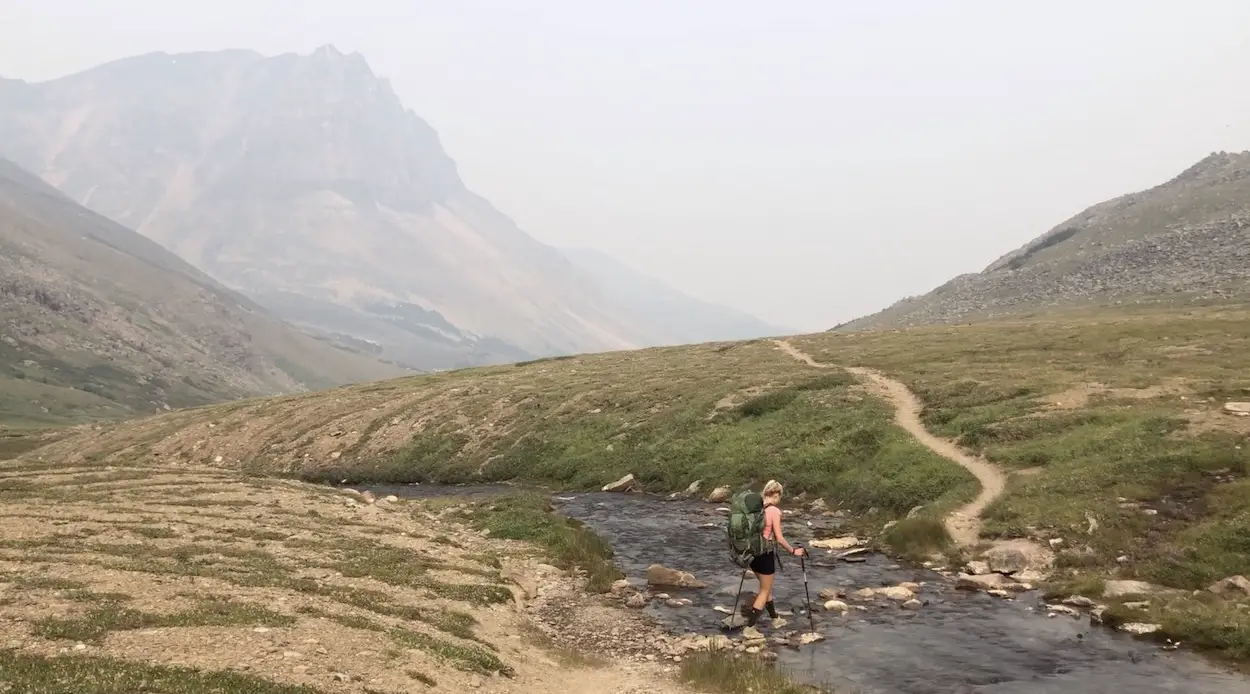
Choosing The Right Hiking Poles
Pole Materials
Hiking poles are typically manufactured with carbon fibre, aluminum or a mix of both.
Aluminum Poles
Aluminum trekking poles are more durable and more affordable than carbon fibre poles. They tend to have a longer lifespan, perform well in all temperatures and can be straightened out if they get bent. I prefer aluminum poles because I’m super hard on my poles and I’m a heavy guy. I like durable equipment and have had carbon poles snap on me. What you gain in durability and cost savings you lose in weight, carbon fibre poles are typically the lightest option of the two. However, thanks to improved technology there are loads of amazing light aluminum pole options. My go to pole for all 4 seasons is the BD Expedition 3 poles, they are aluminum and built for the winter making them a tad heavier than your average hiking pole, but let me tell you, they can withstand a serious beating!
Carbon Fibre Poles
If you like to keep things as light as possible, opt for carbon fibre poles. They are more delicate than aluminum poles but do allow for instant support when they hit the ground thanks to the lack of flex. They are more expensive and less durable than aluminum. If you want to go farther, faster and carry less weight, carbon fibre poles are the answer. The Alpine Carbon Cork Trekking Poles are the much lighter version of the Expedition 3 Pole and are ideal for rugged 4 season adventures.
Pole Style
Telescopic/Extendable
Telescopic trekking poles are poles that can extend and retract. Telescopic poles are ideal for backpacking trips because you can extend the poles to the height you need depending on terrain and when you’re not using them you can easily retract them and attach them to your bag. The downside with telescopic/extendable poles is that because you have additional locking systems on poles you add additional weight. Also more moving parts means a higher potential for failure on the trail.
Telescopic/Extendable poles are without a doubt the best option for backpacking, BUT, ensure you buy poles with a flip lock system and not a twist lock system. I’ve had my pair of Black Diamond Expedition 3 Poles with a flip lock system for 3 years and they’ve never failed. I can’t say the same for my old pair of Leki Twist and extend poles!
Collapsible/Folding
Some poles can collapse/fold allowing them to become extremely small. The advantage with these types of poles is that they can be stored inside your bag very easily. The downside is that folding poles can be more flimsy, less durable and tend to have more issues than traditional telescopic poles. The Komperdell Trailstick Carbon C4 Vario Compact trekking poles are quickly constructed and deconstructed with the press of a button, which makes them pretty darn handy!
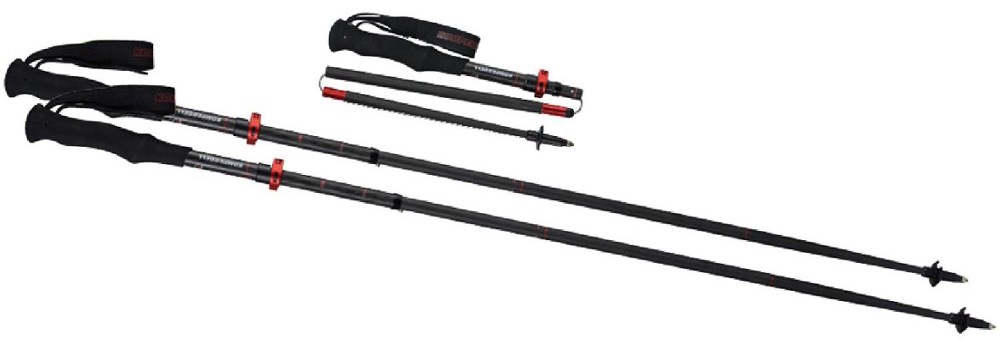
Fixed
Fixed poles are poles that do not extend. They tend to be lighter than telescopic poles and are ideal for day hikers who plan to keep their poles in their hands all the time. Fixed poles can be a hassle if you are the kind of hiker that likes to strap up your poles on your pack for scrambles, on the uphill, or any other time you don’t want to hold them. Fixed poles are long and very hard to attach to a pack and for this reason, and because of the lack of versatility in packing I wouldn’t recommend them for long distance trekking. However, if you are a trail or ultra runner and want a super light and reliable pole, fixed poles like the BC Carbon Distance Trekking Pole are engineered for those who like to go fast and light.
The Pole Handle Style & Grip Material
The style and grips from pole to pole are all different. It really doesn’t matter what the handle style/shape is as long as you find it comfortable. On my Black Diamond Expedition 3 Poles there is an extended foam handle stretching down the pole which provides good grip when I am hiking or ski touring and want to quickly have a shorter pole by choking up and holding a lower portion on the pole neck (this usually happens while traversing on a steep pitch)
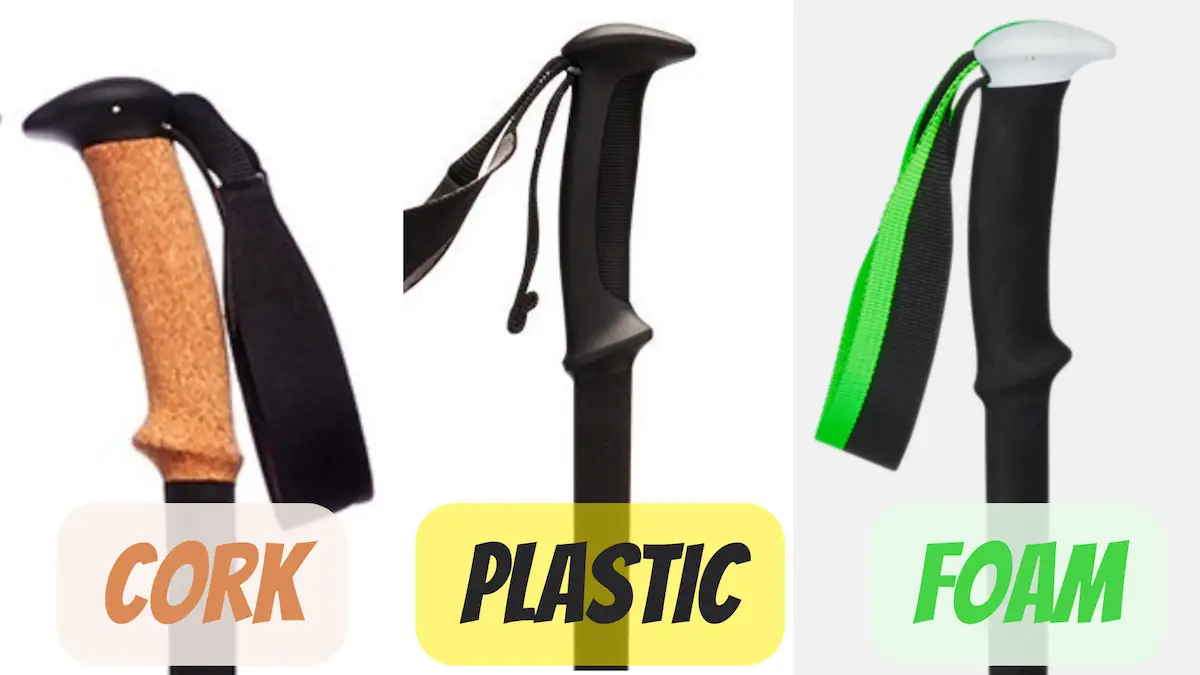
Cork
Cork is the best handle material for hiking and is only found on the most expensive models of poles. It repels water and sweat and shapes to your hand overtime. Thanks to its hydrophobic (water resistant) nature it helps reduce blisters. Cork is quite durable and its only downside is that it’s expensive and rodents and marmots love to nibble on it!
Foam
Foam (what I use) very soft to the touch but absorbs sweat less than cork. Foam is thermo-neutral making it great for winter as well. I’ve still never had any problems with blisters. The biggest issue is that foam degrades over time and is the least durable option. Foam can usually be found in poles in the mid-range price point category
Rubber & Plastic
Rubber and plastic are both very durable and are usually found on more affordable poles. Rubber and Plastic can be uncomfortable and slippery when your hands become sweaty. This slippage on the handle can cause blisters on long trips. Rubber handles are ideal for winter hiking because they are shock and water resistant.
Pole Straps
Make sure you choose a hiking pole with straps. Pole straps provide extra grip and sometimes it is just nice to dangle those poles when you need to use your hands. Also, wearing straps can prevent you from losing your pole when crossing a river. If you don’t like the straps you can always remove them to reduce weight. Straps are more or less the same and can vary slightly in the thickness and material.
Pole Tips and Baskets
Most hiking poles will have small carbide tips. Carbide is used for the tip because it is very hard, durable and can be used on a variety of surfaces. Pole tips can be replaced and I usually have to do so every couple thousand kilometres depending how much rocky terrain I’ve been tackling.
Choose poles with interchangeable baskets so you can use your poles year round. I’ve got a large set of powder baskets for backcountry skiing, a small basket for muddy coastal hiking and I use no basket at all for the majority of my summer hiking.
What Length To Buy
Most hiking pole manufacturers make two different sizes of hiking poles to cater to tall and smaller people! I’d recommend choosing the smallest size pole possible if It works for you because you will be carrying less weight. For the smaller individual opt for the poles that extend from 95-125cm for the taller ones choose a pole that extends to 130cm+. When choosing the length consider if you will be using your poles to hold up your shelter.
Our Recommended Hiking Poles
Best Overall Pole
Black Diamond Trail Ergo Cork Trekking Pole ($175 CAD)
If you want to buy one high quality pole that can crush it on adventures in every single season, look no further than the Black Diamond Trail Ergo Cork. The shape and natural cork grip provides the ultimate comfort for your hands on those long and hot summer hiking adventures and the rubber grip extensions are ideal when you want to quickly choke up on your pole when traversing in winter or tackling steep uphill hiking sections. Black Diamonds flip-lock system is durable, trustworthy and makes it lightning fast to switch the length of your poles when you’re on the move. My favourite part about black diamond poles are their interchangeable tips and variety of powder and mid sized baskets so you can set your pole up for all seasons. The Trail Ergo cork weighs in at 1lb 2oz making it one of the lightest durable aluminum poles in its class.
My Personal Favourite
Black Diamond Trail Back ($110 CAD)
I absolutely love Black Diamonds poles and have been using my Expedition 3 aluminum/telescopic poles for hiking and skiing for the past three years. The BD Trail Back Poles are the more affordable version of the trail ergo cork and the only big difference is that the handle grip is foam and not cork. I personally really like the feel of form and for the price of $90 you really can’t go wrong with such a light, durable, and versatile set of hiking sticks! The dual lock mechanism is trustworthy and simple and the long tips are easy to replace and compatible with snow baskets. The BD Trail Back Trekking poles weigh in at 1lb 4 ounces and will last you years and years of tough adventures.
Best Budget
Cascade Mountain Tech aluminum Adjustable Trekking Poles ($50 CAD)
I typically am very loyal to Black Diamond when it comes to Trekking poles. However, a friend of mine was getting into hiking and purchased the Cascade Mountain Tech Poles from Amazon and I was impressed. These aluminum poles are highly durable and weigh in less than a pound (lighter than many carbon fibre poles). I found them to be strong during testing and thought the quick lock extend and retract system was sturdy. The handle and grip are cork, feel comfortable and the carbide tips are solid. The only downside is that it can be very hard to order replacement parts if something does break. However, for $50 Canadian, you cannot go wrong!
Best 4 Season Ultra-Light Pole
Black Diamond Alpine Carbon Cork Trekking Poles ($240 CAD)
If you want the lightest and greatest 4 season pole from BD you have to check out the BD Alpine Carbon Cork Trekking Poles. These poles are light and absolutely crush it in the hot summer or frigid winter temperatures. They boast a cork handle and rubber extensions perfect for traversing or climbing steep slopes in the summer or winter. They are carbon fibre and are compatible with 100mm powder baskets for the deepest of days.
There you have it. Now you know everything about trekking poles! I owe so much to my hiking poles and cannot stress how much they can improve your hiking experience and reduce pain and injury in your body. Trekking poles are such a versatile tool. Do your knees a favour and try a pair out, I promise you will never go back!
Happy Hiking!

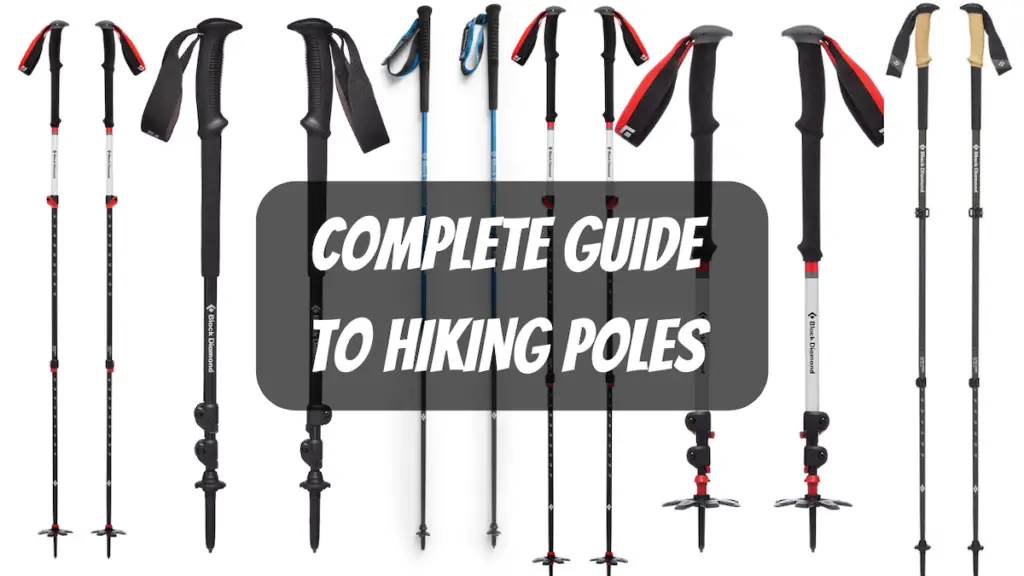
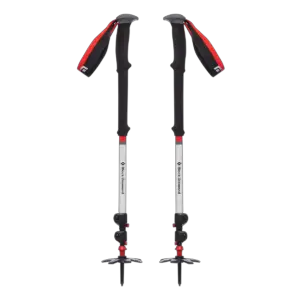


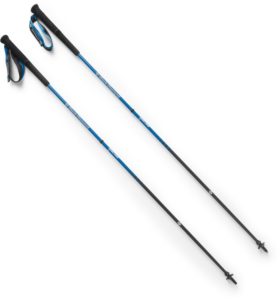
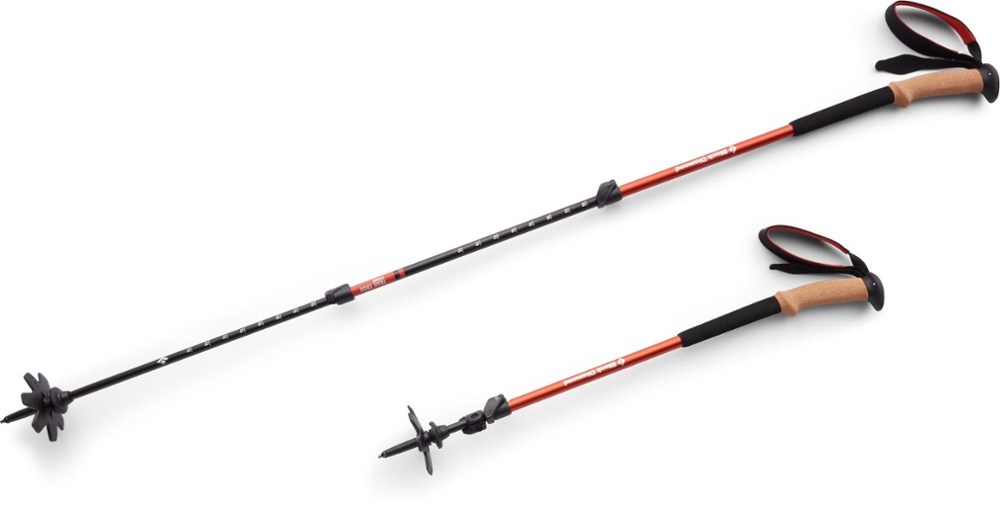



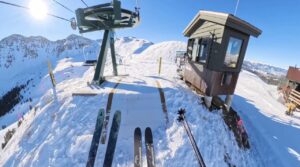








4 Responses
It really helped when you said that you use trekking poles to help you move with better rhythm and also when your knees have issues. I think I would need that when my husband and I climb a mountain in the near future. It would be helpful for me because I have a weird bone on my right knee, and it hurts at times when there is too much impact or when it is cold.
Hi Mia,
Glad the post was helpful!
You totally should try out poles, they won’t take all of the pressure off your knee but they should help a lot!
Hello guys, I need your advice, I am a little overweight but my main problem is that I have a very sore knee and I already broke 2 poles because of the pressure I have to put on them, is there a model or brand that are tougher than others….thanks in advance….
Hey Eric! I break poles all the time, especially while skiing. The most reliable ones I’ve ever had are some old aluminum ones I found at a garage sale. If you’re using them for hiking I’d try to find simple aluminum ski poles that are one piece. The adjustable ones always have weak points. I’ve used baseball bat grip to make the handles more comfortable.